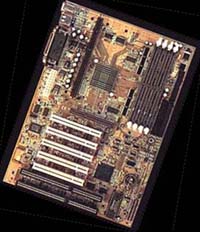Hardware
Audio
Controllers
General
Mainboards
Modems
Monitors
Portables
Printers
Processors
Scanners
Storage
Video
Games
Reviews
Previews
Cheats
& Hints
News
General Info
About
Us
Advertising
Awards
Contact
Us
Hot
Links

Abit BX6 version 2.0 Motherboard Manufactured by Abit
Technologies
Reviewed by Chamila
Sumanasekera
Introduction |
 |
Ever since the release of the Intel 440BX chipset,
Abit carved out a solid reputation for themselves
in the world of motherboards. One of the very
first manufacturers to take a flying leap onto the BX bandwagon back in
April 98, they gave us the Abit BX6 with a new and improved Soft Menu II
setup. If youíre familiar with the old days, you might remember that this
Taiwanese manufacturer was the first to offer motherboards with a jumperless
setup. Then, with the BX6, came manual voltage settings for the CPU -this
feature was not very important at the time, because overclocking was rarer
back then. But after the release of the Celeron processors, it seemed that
everybody wanted a piece of the action. This was when many people began
to realize how important voltage manipulation was, because when you clock
your CPU higher than the set speed, the CPU usually requires a bit more
power to function properly.
Of course, we cannot ignore the importance of
the Soft Menu II feature. This made life much easier
for users when it came to installation and configuration.
Primarily thanks to these main features, the $130 BX6 became an overnight
success. But Abit didnít stop there. Encouraged by the initial success
of the BX6, they went back to their labs and came up with the Abit BH6.
With a retail price of $100, the BH6 was a very affordable upgrade and
became a must-have for any user looking for a new motherboard. One important
change made to the BH6 was the 5/2 PCI/ISA combination, because
the market was getting flooded with PCI peripherals.
In order to save space, Abit also decided to remove one memory socket from
the design to make it a 3-socket solution. Another important change brought
with the BH6 was the SEL66/100# setting, which allowed the user to unlock
the CPU clock multipliers on both the Pentium II 350 and the Pentium II
400. Perhaps not surprisingly, in the light of all this, the BH6 was considered
by most users to be the complete motherboard, and in a very short time
the BH6 became one of the most sought-after motherboards in history.
And now, with the release of the Pentium III processor
just around the corner, Abit has decided to give the world a remake of
the classic BX6. Ladies and gentlemen, welcome the second version of
the Abit BX6.
 |